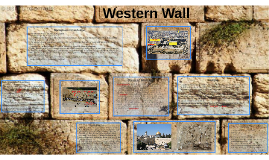Background Knowledge
Transcript: To withstand the soil pressure of the filling behind the Wall, the rows were placed in a terraced manner, each row set back a few centimeters relative to the one beneath it, making the wall slant slightly eastward. It is customary to leave the Western Wall plaza by walking backwards, in order not to turn your back on the holy site in haste. WesternWallWish.com allows anyone to submit a wish to the Western Wall in Jerusalem. Today, more than a million prayer notes and wishes are placed in the Western Wall each year. You can find notes in any language or format placed in the wall. Since 132 CE , the prayers of Israel both in the Land of Israel and throughout the jewish community were directed towards the site of the destroyed Temple. The Temple itself, as well as all the structures on the Temple Mount, became endeared to the Jews. The Midrashic sources of this period speak about the Western Wall of the Holy of Holies from which the Divine Presence never moves. Since the Holy of Holies was destroyed, the notion of eternal Divine Presence became associated with the Western Wall of the Temple Mount. Thenceforth all literary sources describe it as a place of assembly and prayer for Jews. Fun Facts The Western Wall is located in Jerusalem. It was built by King Herod in 20 BC. It was built during the expansion of the Temple enclosure, and is part of the retaining wall that enclosed the western part of Temple Mount. The Western Wall is one of four retaining walls that surrounded the Temple Mount at the end of the Second Temple Period. According to the Roman Jewish historian Josephus, it took 11 years to complete. During the Ottoman Period, the wall became the Jews' chief place of pilgrimage, where they came to mourn the destruction of the Temple that took place in 70 AD which later influenced it to be called the wailing wall. The wall originally consist of 24 rows of stone, roughly 59 feet high but in 1867 excavations revealed 19 more rows buried underground. The western Wall Plaza was created to be able to accommodate tens of thousand pilgrims instead of only a couple hundred with the western Wall itself. Jesus Christ was brought to Jerusalem for pilgrimages to the Holy Temple as a child. As noted in the Bible, Jesus was a frequent visitor to the Temple, and this is where he challenged the local authorities, a move that eventually led to his arrest and crucifixion. The actions of many modern Christian leaders, including Pope John Paul II and Pope Benedict XVI, who visited the Wall and left prayer messages in its crevices, have symbolized for many Christians a restoration of respect and even honor for this ancient religious site. Western Wall Significance In Judaism Sources Visitors to the Western Wall must enter the plaza adjacent to the Western Wall through one of few entrances with guards and metal detectors. Women wanting to approach the wall to pray or observe may only do so wearing modest clothing. Appropriate clothing is neutral colored trousers and top with sleeves. If a female visitor is wearing a sleeveless shirt, there are dark-colored shawls available in a basket to wrap around her arms. If she is wearing a short skirt that reveals her legs, she will be asked to wrap a provided cover around her. Men wishing to enter the prayer section of the wall are required to wear either a Jewish skull cap called a yamakah or kippah or a hat. http://www.sacred-destinations.com/israel/jerusalem-western-wall http://mosaic.lk.net/g-wall.html http://www.aish.com/h/9av/j/48961906.html http://www.jewishvirtuallibrary.org/jsource/myths3/MFjerusalem.html#2 http://shalomholytours.com/significance-western-wall-christians/ http://www.smithsonianmag.com/history/what-is-beneath-the-temple-mount-920764/ http://westernwallwish.com/christian-jerusalem https://en.wikipedia.org/wiki/Western_Wall#Sanctity_of_the_Wall http://www.ehow.com/how_6121753_dress-properly-wailing-wall-jerusalem.html http://judaism.about.com/od/jewishhistory/fl/The-Western-Wall-A-Quick-History.htm Natan Sharansky, the chairman of the Jewish Agency, outlined new ideas for making the Western Wall a place where all Jews could pray comfortably, after tensions over rituals there peaked in recent months and caused discord between the Israeli authorities and Jewish leaders abroad. Mr. Sharansky’s proposal involves expanding and improving the areas accessible for prayer at the wall to include the southern section known as Robinson’s Arch which, under his plan, would be open for Jews wishing to pray in a less Orthodox, more egalitarian style 24 hours a day, seven days a week. The main prayer section, which is now divided into men’s and women’s sections, would remain the domain of more traditional worshippers. Recent History Visiting Significance In Christianity Background knowledge

















